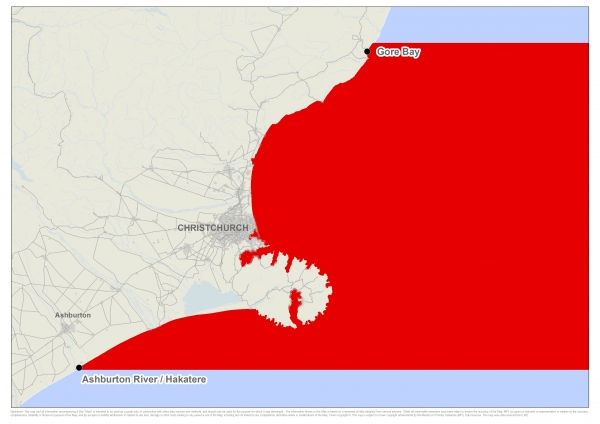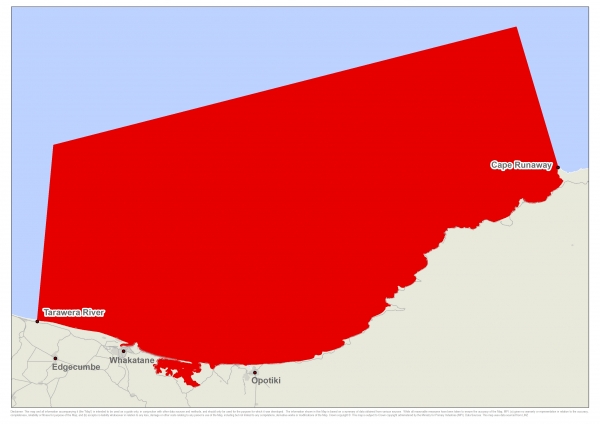Public warnings about toxic shellfish
Shellfish and seawater samples are taken every week from popular shellfish gathering areas around New Zealand and are tested for the presence of toxic algae. If the shellfish are not safe to eat, then public health warnings are issued and signs are posted at affected beaches.
The information on this page relates only to the non-commercial (recreational and traditional) taking of shellfish. Commercially harvested shellfish – sold in shops and supermarkets, or exported – is subject to strict water and flesh monitoring programmes by MPI to ensure they are safe to eat.
Subscribe to email updates about shellfish biotoxin warnings
North Island warnings
Northland East Coast
| Reason for alert | Paralytic Shellfish Poisoning (PSP) |
| Date warning issued | 11th January 2017 - Still valid as of 27 January 2017 |
| Affected area | The Northland east coast area between Cape Brett in the north to Taiharuru Head in the south. |
| Shellfish affected | Mussels, oysters, tuatua, pipi, toheroa, cockles, scallops, catseyes, kina (sea urchin) and all other bivalve shellfish. Note, cooking shellfish does NOT remove the toxin. Pāua, crab and crayfish may still be eaten if the gut has been completely removed prior to cooking, as toxins accumulate in the gut. If the gut is not removed its contents could contaminate the meat during the cooking process |
| Other information | PSP toxins have been detected in shellfish at levels of up to 1.5mg/kg which is over the safe limit of 0.8mg/kg set by MPI. Ongoing testing will continue and any changes will be communicated accordingly. Members of the public with queries about shellfish safety may call Whangarei Hospital, phone 09 4304100 and request the on-call Health Protection Officer. |
Map: Eastern Coast of Northland

South Island warnings
There is one warning in place for the South Island:
- Ashburton River to Gore Bay
Ashburton River to Gore Bay
| Reason for alert | Diarrhetic Shellfish Poisoning (DSP) |
| Date warning issued | 13 October 2016 |
| Affected area | Between Ashburton River and Gore Bay |
| Shellfish affected | Do not eat mussels, oysters, tuatua, pipi, toheroa, cockles, scallops, catseyes, kina (sea urchin) and all other bivalve shellfish. Note: cooking shellfish does not remove the toxin. Pāua, crab and crayfish may still be eaten if the gut has been completely removed prior to cooking, as toxins accumulate in the gut. If the gut is not removed its contents could contaminate the meat during the cooking process. |
| Other information | DSP toxins have been detected in shellfish at levels over the safe limit of 0.16mg/kg set by MPI. Ongoing testing will continue and any changes will be communicated accordingly. |
Map: The affected area in the Canterbury region
 Map showing the area covered by the shellfish biotoxin alert.
Map showing the area covered by the shellfish biotoxin alert.
If you get sick after eating shellfish
If anyone becomes ill after eating shellfish from an area where a public health warning has been issued:
- phone Healthline for advice on 0800 61 11 16, or seek medical attention immediately
- advise your nearest public health unit
- keep any leftover shellfish for testing.
Find your nearest public health unit
Find out more
- Food Safety for Seafood Gatherers booklet
- Causes and symptoms of toxic shellfish poisoning
- Toxic algal blooms
- Collecting Shellfish and Keeping Them Safe
Eastern Bay of Plenty
| Reason for alert | Paralytic Shellfish Poisoning (PSP) |
| Date warning issued | 23 November 2016 |
| Affected area | All coastline between Cape Runaway and the Tarawera River mouth near Matata. The warning includes Ohiwa Harbour. |
| Shellfish affected | Do not eat mussels, oysters, tuatua, pipi, toheroa, cockles, scallops, catseyes, kina (sea urchin) and all other bivalve shellfish. Note, cooking shellfish does NOT remove the toxin. Pāua, crab and crayfish may still be eaten if the gut has been completely removed prior to cooking, as toxins accumulate in the gut. If the gut is not removed its contents could contaminate the meat during the cooking process. |
| Other information | PSP toxins have been detected in shellfish at levels over the safe limit of 0.8mg/kg set by MPI. Ongoing testing will continue and any changes will be communicated accordingly. Anyone eating shellfish from this area is at a real risk of illness. |
Map: The affected area in the Eastern Bay of Plenty region
 Map showing the area covered by the shellfish biotoxin alert.
Map showing the area covered by the shellfish biotoxin alert.
South Island warnings
There is one warning in place for the South Island:
Ashburton River to Gore Bay
Ashburton River to Gore Bay
| Reason for alert | Diarrhetic Shellfish Poisoning (DSP) |
| Date warning issued | 13 October 2016 |
| Affected area | Between Ashburton River and Gore Bay |
| Shellfish affected | Do not eat mussels, oysters, tuatua, pipi, toheroa, cockles, scallops, catseyes, kina (sea urchin) and all other bivalve shellfish. Note: cooking shellfish does not remove the toxin. Pāua, crab and crayfish may still be eaten if the gut has been completely removed prior to cooking, as toxins accumulate in the gut. If the gut is not removed its contents could contaminate the meat during the cooking process. |
| Other information | DSP toxins have been detected in shellfish at levels over the safe limit of 0.16mg/kg set by MPI. Ongoing testing will continue and any changes will be communicated accordingly. |
Map: The affected area in the Canterbury region
 Map showing the area covered by the shellfish biotoxin alert.
Map showing the area covered by the shellfish biotoxin alert.
If you get sick after eating shellfish
If anyone becomes ill after eating shellfish from an area where a public health warning has been issued:
phone Healthline for advice on 0800 61 11 16, or seek medical attention immediatelyadvise your nearest public health unitkeep any leftover shellfish for testing.
Find your nearest public health unit